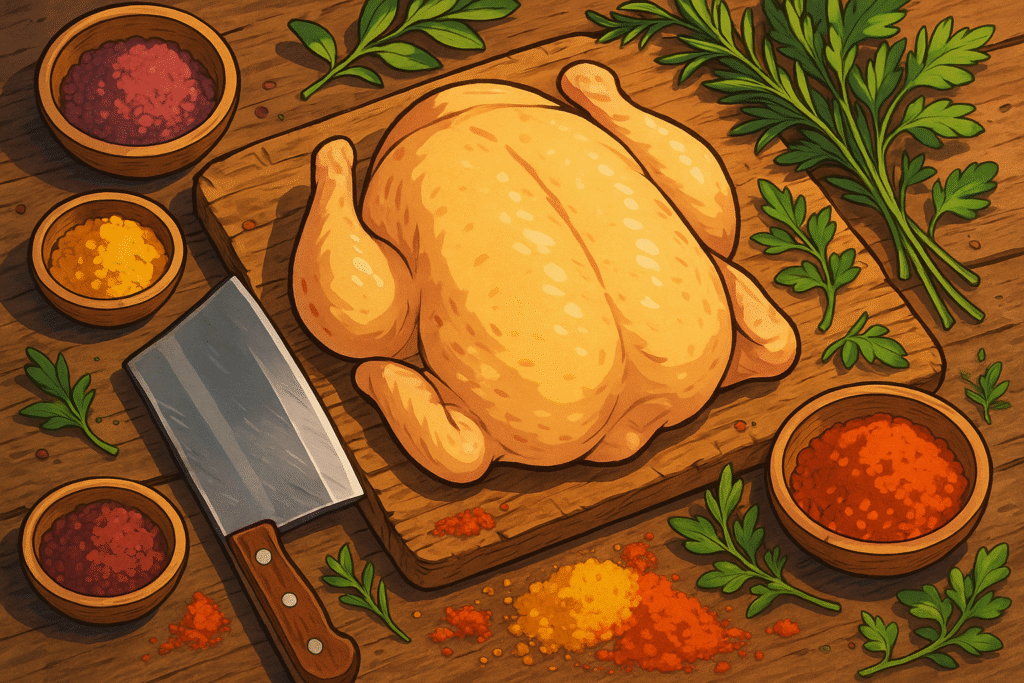Chicken (Gallus gallus domesticus)

About Chicken
Chicken is the most widely consumed meat in the world — and for good reason. It’s incredibly versatile, mildly flavored, and takes on spices, sauces, and cooking methods from every cuisine imaginable. Whether roasted, fried, poached, or grilled, chicken is a culinary chameleon.
Its appeal isn’t just convenience. Across cultures, chicken dishes often carry symbolic or celebratory meaning — from fried chicken in the American South to whole poached chicken in Chinese New Year feasts.
The History of Chicken
Chicken was first domesticated over 8,000 years ago from wild junglefowl in Southeast Asia. Originally bred for cockfighting and rituals, chickens gradually became a food source due to their ability to reproduce quickly and live in diverse environments.
The bird spread along trade routes from India to Egypt, Greece, and eventually Europe and the Americas. Over time, selective breeding transformed chickens from lean, flighty creatures into plump, meat-producing animals.
In modern times, chicken is both sacred and everyday — featured in religious feasts, fast food chains, and haute cuisine alike.
The Science of Chicken
Chicken meat is composed primarily of lean muscle, with different textures across the bird. White meat (breast) has fast-twitch fibers, making it tender but drier. Dark meat (thighs, drumsticks) contains more myoglobin and fat, giving it richer flavor and moisture.
Chicken is also a food safety case study — prone to bacterial contamination if undercooked or mishandled. Cooking it to at least 74°C (165°F) is essential for safety.
Flavor-wise, chicken is subtle on its own, but its low fat and neutral profile make it a perfect canvas for seasoning.
The Geography of Chicken
Chicken is raised almost everywhere — from backyard flocks in Ethiopia to industrial farms in the U.S. The bird’s flavor and texture can change dramatically depending on feed, breed, and living conditions.
Free-range and pasture-raised birds tend to have firmer meat and deeper flavor. In France, the Poulet de Bresse is prized for its terroir-influenced taste. Meanwhile, Southeast Asia celebrates leaner breeds like Kampong chicken for soups and stews.
Varieties of Chicken
Cornish Cross
The standard commercial breed — fast-growing, plump, and mild-tasting. Common in supermarkets worldwide.
Poulet de Bresse
A French heritage breed with AOC status. Noted for its rich flavor and yellow fat, often roasted whole.
Silkie
A Chinese breed with black skin and bones, used medicinally and in traditional broths. Mild and slightly gelatinous.
Kampong Chicken
Free-range birds in Southeast Asia known for lean meat and pronounced flavor. Often used in herbal soups or rice dishes.
Jersey Giant
A U.S. heritage breed with dense, dark meat. Slower growing and more flavorful than commercial varieties.
FAQs All your questions about Chicken: answered
Why is chicken white and dark in different parts?
White meat comes from muscles used less (like the breast), which are fast-twitch and low in myoglobin. Dark meat comes from more active muscles like thighs and has more oxygen-carrying proteins.
Can you eat chicken rare?
No. Chicken must be fully cooked to avoid salmonella and other bacteria. Always reach an internal temp of 74°C (165°F).
What’s the difference between free-range and pasture-raised?
Free-range means chickens have access to the outdoors. Pasture-raised typically means they live most of their lives on grass, which can improve taste and nutrition.
Why does leftover chicken taste different?
Refrigeration and reheating alter its texture and can bring out sulfur compounds, slightly changing flavor.